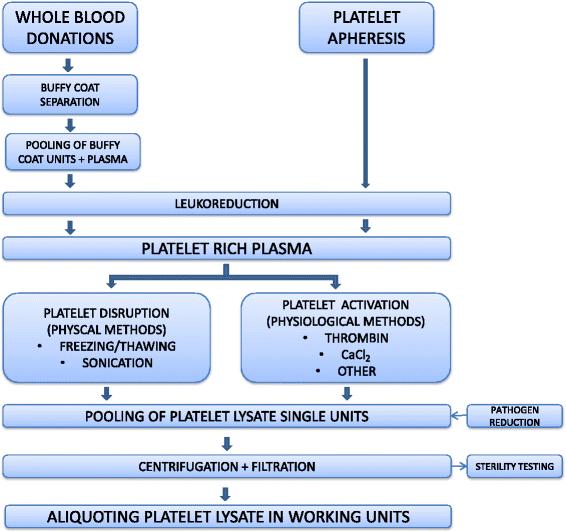Platelet lysate as a substitute for animal serum for the ex-vivo expansion of mesenchymal stem/stromal cells: present and future
- PMID: 27411942
- PMCID: PMC4944312
- DOI: 10.1186/s13287-016-0352-x
Platelet lysate as a substitute for animal serum for the ex-vivo expansion of mesenchymal stem/stromal cells: present and future
Abstract
The use of fetal bovine serum (FBS) as a cell culture supplement is discouraged by regulatory authorities to limit the risk of zoonoses and xenogeneic immune reactions in the transplanted host. Additionally, FBS production came under scrutiny due to animal welfare concerns. Platelet derivatives have been proposed as FBS substitutes for the ex-vivo expansion of mesenchymal stem/stromal cells (MSCs) since platelet-derived growth factors can promote MSC ex-vivo expansion. Platelet-derived growth factors are present in platelet lysate (PL) obtained after repeated freezing-thawing cycles of the platelet-rich plasma or by applying physiological stimuli such as thrombin or CaCl2.PL-expanded MSCs have been used already in the clinic, taking advantage of their faster proliferation compared with FBS-expanded preparations. Should PL be applied to other biopharmaceutical products, its demand is likely to increase dramatically. The use of fresh platelet units for the production of PL raises concerns due to limited availability of platelet donors. Expired units might represent an alternative, but further data are needed to define safety, including pathogen reduction, and functionality of the obtained PL. In addition, relevant questions concerning the definition of PL release criteria, including concentration ranges of specific growth factors in PL batches for various clinical indications, also need to be addressed. We are still far from a common definition of PL and standardized PL manufacture due to our limited knowledge of the mechanisms that mediate PL-promoting cell growth. Here, we concisely discuss aspects of PL as MSC culture supplement as a preliminary step towards an agreed definition of the required characteristics of PL for the requirements of manufacturers and users.
Keywords: Fetal bovine serum; Manufacturing; Mesenchymal stem/stromal cells; Pathogen reduction; Platelet lysate; Platelet releasate.
Figures
References
-
- Kuci Z, Seiberth J, Latifi-Pupovci H, Wehner S, Stein S, Grez M, et al. Clonal analysis of multipotent stromal cells derived from CD271+ bone marrow mononuclear cells: functional heterogeneity and different mechanisms of allosuppression. Haematologica. 2013;98(10):1609–16. doi: 10.3324/haematol.2013.092700. - DOI - PMC - PubMed
Publication types
MeSH terms
Substances
LinkOut - more resources
Full Text Sources
Other Literature Sources


